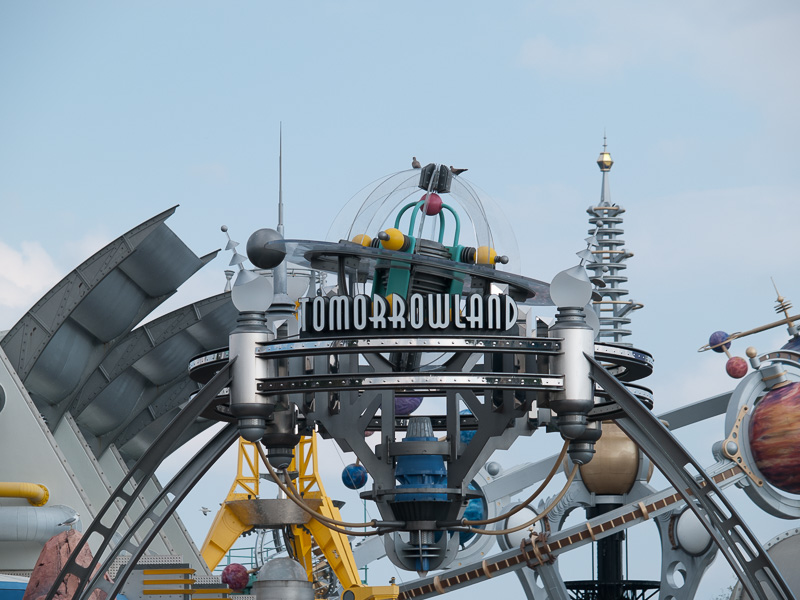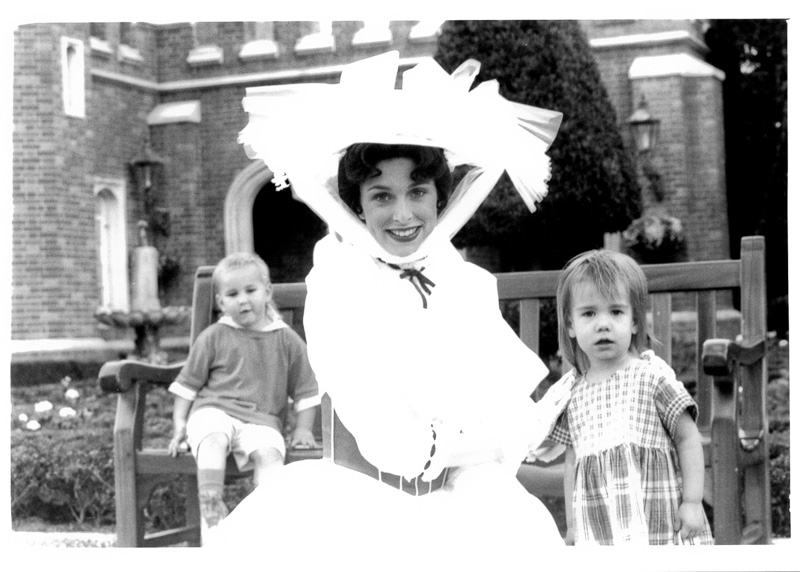My name is Dave and I am a Disneyholic…
Hello, Dave. Why don’t you tell us a bit about yourself and your struggles with Disney addiction?
Well, it all started innocently enough with Sunday evening TV — 6 o’clock dinner on a TV tray, watching Old Yeller in black and white. Even now, when I eat my mom’s famous casserole, I have an urge to bark. Things got more serious when we took Christmas vacations in Florida. We were supposed to be visiting family. There was an uncle with a pecan farm somewhere in the north end of the state, and an aunt in St. Petersburg. But for all our family visits, Orlando had its hold on us, a magnetic tug that drew us into the land of reclaimed swamp and fairy tales.
The first time I went to Disney World was — oh — probably the year after the park opened. I spent the next summer pretending I was Fritz Robinson and building a tree house in the back yard. We didn’t have a library or a pump organ in our tree house, but we armed it with water balloons and soaked my brother. I built it with the kid next door who had been to Disney World the year it opened. His parents were better than my parents.
Our family went back in 1976 when a visit to the Hall of Presidents was obligatory. I remember being amazed that they could figure out what Abe Lincoln’s voice sounded like, especially since he had died before they invented sound recording technology. But Disney could do anything. They probably had a time machine and went back to Gettysburg to tape his address. I had just become a teenager and remember having impure thoughts about Snow White.
There was another visit in my late teens which I don’t remember except for two things:
1. My impure thoughts about Snow White now included Cinderella, and
2. I got into a conversation with a cast member (one of those “Oh, you’re from Toronto? I have a friend from Toronto. Maybe you know him” conversations) which took a turn for the improbable when I realized I actually did know his friend from Toronto. What are the odds? I felt a sudden urge to buy a state lottery ticket.
They say addiction is hereditary. Is it nature? Is it nurture? Who knows? All I know is this: despite my better judgment, I exposed my children to the same toxic environment. I’m wracked with guilt. The first time was in 1995. We took the kids to the Magic Kingdom, then Epcot, Disney’s Hollywood Studios, Downtown Disney, Discovery Island. We OD’d on Disney. When we got home, we checked into rehab. We thought we had kicked it, but two years later, we were back — and again, and again. Charlie Sheen sent us sympathy cards.
Now it’s 2011 and we’ve just got back from another family visit — one last fix before we go straight. If you’re in this room with me, you may have said the same thing, and you know what a lie it is. The fix doesn’t do it for me anymore. The highs aren’t high enough. The roller coasters aren’t fast enough. The animatronics aren’t real enough. I’ve grown jaded. Now that I look through jaded eyes, I notice things I never saw before and ask awkward questions:
1. Why is there no toilet in the Swiss Family Robinson tree house?
The SFR tree house is the paradigm of kitsch. Elsewhere, I have discussed Milan Kundera’s definition of kitsch as the denial of shit. Art can be distinguished from kitsch because art incorporates all of life — especially the marginal and the disgusting — while still staking a claim in our aesthetic sensibilities. Michelangelo gave Adam a penis. Pope Julius II — CEO of Disney’s kitschiest of kitschy rivals — forced him to cover it up. And as we rode through the Spaceship Earth exhibit at Epcot (a sweeping history of human communication) we saw an animatronic Michelangelo painting a ceiling to a chorus of “Hallelujahs” and not a penis in sight. To answer my own question, there is no toilet in the SFR tree house because kitsch is the Disney kredo and so shit is an impossibility. But if you’re walking underneath, bring an umbrella just in case.
2. Why does Tomorrowland never change?
The first time I visited Tomorrowland, they were going on about space travel and about how, one day, these massive things called computers would be small enough to fit in your garage. Forty years later, the whole park paused at 4:50 pm to watch Discovery’s final launch which I captured in HD 720p video using my — my what? — my phone? — are you kidding me? — yes, I captured it on a pocket-sized device with a microprocessor more powerful than the most powerful computer that existed when I first visited Disney World. And yet Tomorrowland hasn’t changed. You’d think that in the last forty years, Tomorrowland’s tomorrow would have advanced by forty years. Instead, its vision of tomorrow is stuck firmly in the past.

Disney is now discovering the paradox that Church has faced for nearly two millennia. It seeks to enshrine enduring values, to give them permanence in physical monuments and an immutable iconography. And yet it also seeks to reveal a hopeful future. How can it be both unchanging and forward-looking? Like Church, Disney faces a crisis of relevance. Everybody wants there to be a Small World ride, but everybody who rides it thinks: “What a piece of cheese!” Disney wants to provide an experience which is fun for the whole family but, in the spirit of kitsch, can’t present anything but the family of the McCarthy era — a mythical creation that didn’t exist even when it did exist. Meanwhile the man who penned one of Disney’s most successful musical animations is married to another man and has adopted a child.
3. Why isn’t Mary Poppins Filipino?
Or…who ever heard of a nanny who is Caucasian and speaks the Queen’s English? This is probably a bigger question about race and post-colonialism. During the jungle boat cruise, the savages stand on the river bank and menace us with their spears, and somewhere in the background, the ghost of Rudyard Kipling groans. Maybe its time to put that ghost to rest. Meanwhile, out in Frontierland, savages of a different sort look on as white women settle their infants in strollers.

Disney is a museum. It has preserved a record of post-war North American attitudes. It’s an anthropological exhibit, a tour of a white man’s mind. The map of the Magic Kingdom, with its Frontierland, Fantasyland, Adventureland, Liberty Square, Tomorrowland, Main Street, makes a perfect overlay of the human brain: Frontal lobe, Parietal lobe, Occipital lobe, Cerebellum, Temporal lobe, Brain stem.
4. In Disney Village, why is there a Muslim flying past the Twin Towers?
Seriously. Aladdin, Princess Jasmine, and their monkey, are riding on a magic carpet with an image of the Twin Towers in the background. Shouldn’t they be on some no-fly list? That illustrates something surprising about Disney: it aspires to a liberal world view. It respects diversity and resists the ignorant association between Islam and violence. This makes the savages in the jungle boat cruise all the more puzzling.

5. Whatever happened to feminism?
This is a question I’ve posed in other contexts. Maybe, in the context of Disney, a better question is: has Disney ever heard of feminism? There she is — the princess — forever waiting to be rescued or completed by her prince charming, forever waving to little girls, encouraging them to wait just like her. Disney has offered more active “princess” figures like Mulan and Pocahontas, but these women give; they never take. Theirs are quests on behalf of a whole people. Disney males get a piece of the pie to keep for themselves. Simba gets to be the lion king. Aladdin gets to rule his kingdom. But the women? Have you seen the sequels? Mulan goes back to doing dishes in the family restaurant and Pocahontas ends up cooking meals for the ten children she bears. And don’t get me started on Disney affirmative action. Princesses of colour get to enjoy the same uncomfortable dresses as their Caucasian counterparts.
Down and Out in the Magic Kingdom
Just a final note about the title of this post, which comes from the Cory Doctorow novel of the same name and which you can download for free. It’s a science fiction novel set in the Magic Kingdom and imagines a hi-hi-hi-tech version of the Haunted Mansion…and the chaos that ensues when people propose a change to the ride. Yes, although Disney claims that the Magic Kingdom is a place where you can fly away with your imagination, the one thing that is almost unimaginable is changing it.
